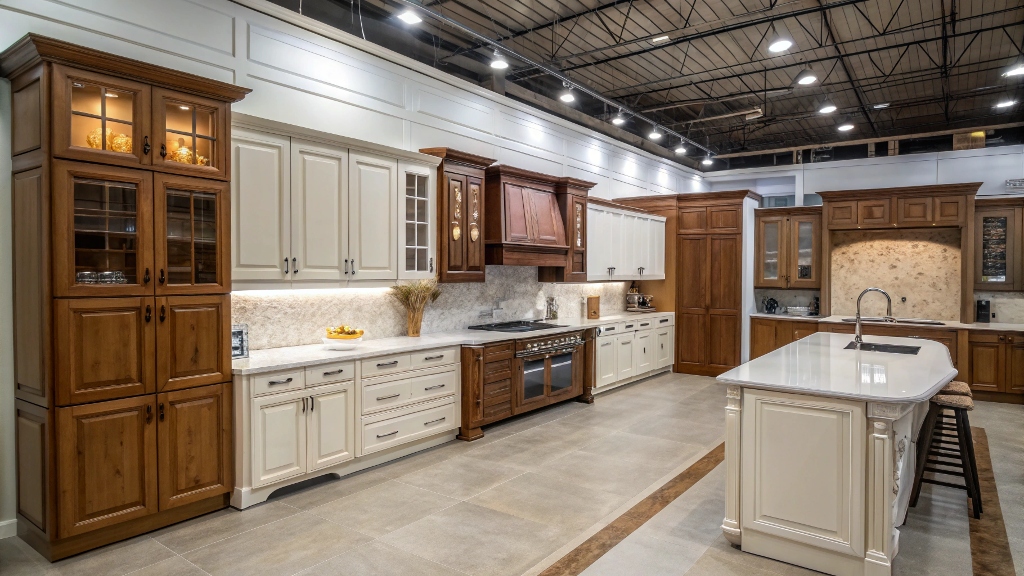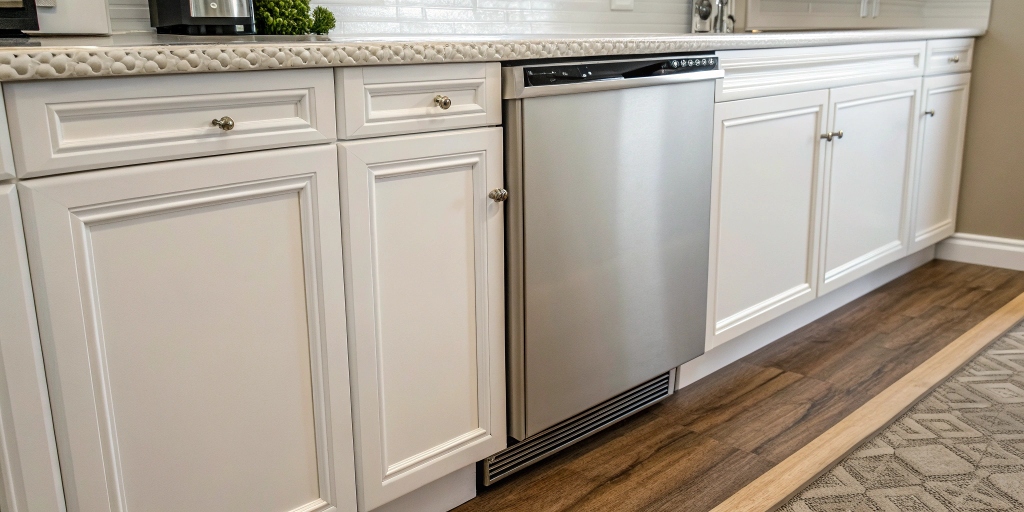Embarking on a modern home remodel is an exhilarating journey, transforming your living space into a reflection of contemporary style and personal needs. At the heart of this transformation, particularly in kitchens, bathrooms, and living areas, lie the cabinets. Far more than mere storage boxes, cabinets are foundational design elements that dictate the room’s aesthetic flow, functionality, and overall atmosphere. While stock options abound, choosing custom cabinets unlocks a realm of unparalleled personalization and precision, ensuring your modern vision is realized flawlessly. But how do you navigate the choices to select the perfect custom cabinets? This guide delves into the key considerations, from defining the modern look to understanding materials, functionality, and the bespoke process itself.
Defining the Modern Aesthetic in Cabinetry
Modern design, often intertwined with minimalism, champions clean lines, uncluttered surfaces, and a distinct lack of fussy ornamentation. When translating this into cabinetry, specific characteristics come to the forefront. Think sleek profiles, smooth textures, and geometric simplicity. One of the defining features often seen in modern custom cabinetry is frameless construction, also known as Euro-style. Unlike traditional framed cabinets where the door rests on or within a visible frame attached to the cabinet box, frameless cabinets have doors that cover the entire cabinet box edge-to-edge, creating tighter reveals and a seamless, integrated look. This construction inherently maximizes interior access and storage space, aligning perfectly with modern efficiency.
The door style itself is paramount in achieving a modern look. Slab doors, essentially flat panels without any beveling or detailing, are the quintessential choice. Their utter simplicity offers a clean canvas that highlights the chosen material and finish. Flat-panel doors, which might include subtle Shaker-style influences but maintain minimal detailing, can also work within a modern context, bridging the gap towards transitional styles if desired. Increasingly, handle-less designs dominate modern aesthetics, utilizing integrated channel pulls (like J-pulls discreetly routed into the door edge) or sophisticated push-to-open mechanisms, further emphasizing uninterrupted surfaces and effortless chic.
Material Matters: Selecting the Right Foundation
The material you choose for your custom cabinets forms their structural and visual core. Modern design embraces a variety of materials, often celebrating their inherent textures or opting for manufactured perfection. Wood veneers, thin slices of real wood applied over a stable substrate like MDF or plywood, are increasingly popular. They offer the warmth and unique grain patterns of species like white oak or walnut – currently trending for bringing organic texture back into modern spaces – often with greater stability and potentially lower cost than solid wood. Look for sustainable options like FSC-certified woods or rapidly renewable choices like bamboo.
Engineered woods like Medium-Density Fiberboard (MDF) and High-Density Fiberboard High Moisture-Resistance (HDF-HMR) are workhorses in modern cabinetry. MDF provides an incredibly smooth, stable surface ideal for flawless paint applications in any imaginable color. HDF-HMR offers enhanced durability and crucial resistance to moisture, making it an excellent choice for cabinet boxes, especially around sink areas or in humid climates. For the ultimate sleek, high-tech, or bold color statement, consider high-gloss or matte finishes achieved through laminates, thermofoil, or acrylics. These offer durability, ease of cleaning, and vast color/pattern options, though ultra-high-gloss might be giving way slightly to sophisticated matte and satin finishes. Don’t forget the power of accents: incorporating elements like frosted or back-painted glass doors can add lightness and display opportunities, while touches of metal (stainless steel, brushed aluminum, matte black) can introduce an industrial edge or refined detail.
Functionality Meets Form: Layout and Internal Organization
A hallmark of successful modern design is that it works as beautifully as it looks. The clean exterior of modern custom cabinets should hide a powerhouse of smart organization within. Customization allows you to tailor the interior layout precisely to your needs and the room’s flow, moving beyond generic shelving. Think deep drawers meticulously divided for pots, pans, and utensils; vertical partitions for baking sheets and cutting boards; pull-out pantry units that bring contents into easy reach; and clever corner solutions like Lazy Susans or LeMans units that conquer awkward dead space.
Integrating functionality seamlessly is key. Consider appliance garages with retractable doors to keep countertops clutter-free. Opt for integrated waste and recycling pull-outs hidden within cabinetry. Panel-ready appliances, designed to accept custom cabinet fronts, allow refrigerators, dishwashers, and even ventilation hoods to blend invisibly into the surrounding cabinetry, reinforcing the sleek, uninterrupted aesthetic. During the design phase, work with your designer or cabinet maker to map out work zones (prep, cooking, cleaning) and ensure ergonomic placement of frequently used items, maximizing efficiency and comfort in your daily routines.
The Finishing Touches: Hardware and Color Palettes
While handle-less designs are popular, hardware still plays a crucial role in many modern cabinet schemes, acting as functional jewelry. The key is subtlety and clean lines. Opt for minimalist hardware like slim linear bar pulls, discreet edge pulls that mount atop or alongside doors/drawers, or simple, geometric knobs. Finishes like matte black, brushed brass or gold (adding warmth), brushed or polished nickel, and chrome are all popular choices that complement modern palettes. The hardware should enhance, not distract from, the cabinet’s form.
Color is where you can truly personalize your modern space. While all-white kitchens are classic, the trend is moving towards warmer, more nuanced palettes. Think sophisticated neutrals like soft grays, warm beiges, taupes, and deep charcoals. Natural wood tones, especially lighter oaks and richer walnuts, are making a significant comeback, often used for entire kitchens or as warming accents. Don’t shy away from color, though! Bold statements are increasingly popular, with deep, saturated hues like forest green, navy blue, or even black used for accent walls of cabinetry, islands, or lower cabinets in two-tone schemes. Two-tone designs, pairing a neutral or wood tone with a bolder color, or light uppers with dark lowers, add depth and visual interest. Remember to coordinate your cabinet colors and finishes with your countertop, backsplash, flooring, and wall paint for a cohesive and intentional modern look. Consider matte or satin finishes for a sophisticated, contemporary feel.
The Custom Cabinet Process: From Concept to Completion
Choosing custom cabinets involves a collaborative process designed to translate your vision into reality. It typically begins with an initial consultation where you discuss your needs, lifestyle, aesthetic preferences, inspirations (bring photos!), and budget with a designer or cabinet maker. Clear communication at this stage is vital. Next comes the design and measurement phase. Professionals will take precise measurements of your space and develop initial concepts and layouts, often using 3D rendering software to help you visualize the final result. This allows for refinement of the design before moving forward.
Once the layout is approved, you’ll dive into material and finish selection, choosing the specific wood, veneer, laminate, paint color, stain, and hardware that align with your design and budget. Following your approval of detailed shop drawings, the fabrication process begins. Skilled craftspeople will meticulously build your cabinets to the exact specifications using quality materials and construction techniques (like dovetail joints for drawers). Finally, the professional installation team carefully installs the cabinets in your home, ensuring a perfect fit, level surfaces, and proper function. Be aware that this bespoke process takes time; expect a timeline of anywhere from 6 to 12 weeks or more from design finalization to installation, depending on complexity and the cabinet maker’s schedule.
Gift Ideas for Small Business Owners in 2025
Budgeting for Your Dream Cabinets
Custom cabinetry is undeniably an investment, representing a significant portion of many remodel budgets. While prices vary widely based on location, materials, and complexity, costs are often estimated per linear foot, commonly ranging from $500 to $1,200 or more. It’s crucial to understand the factors driving this cost. Premium materials like solid hardwoods will cost more than engineered woods or laminates. The sheer volume of cabinetry needed, the complexity of the design (curved elements, intricate details), the type of finish (multi-step lacquers vs. standard paint), high-end hardware, and extensive internal organizers all impact the final price. Don’t forget labor and installation, which can account for a substantial percentage of the total cost.
While stock cabinets are the most budget-friendly and semi-custom offer some modifications, neither provides the complete design freedom, perfect fit, or tailored functionality of true custom work – often essential for achieving a high-end, integrated modern look, especially in unique spaces. To manage costs, discuss priorities with your designer. Perhaps opt for a more cost-effective material for cabinet boxes while splurging on the door fronts, or choose simpler internal organizers initially. Always get detailed, itemized quotes from several reputable custom cabinet makers to compare apples to apples, ensuring you understand precisely what is included in the price.
Read More Also: How to Fix a Sagging Wooden Floor: Comprehensive Guide
People Also Ask (FAQs)
Q1: What defines modern kitchen cabinets?
- Modern kitchen cabinets are primarily defined by their clean lines, minimalist aesthetic, and lack of ornate details. Key features often include flat-panel (slab) doors, frameless (Euro-style) construction for a seamless look, simple or integrated hardware (including handle-less push-to-open options), and smooth finishes. Color palettes range from crisp neutrals to bold, saturated hues or natural wood tones.
Q2: Are custom cabinets worth the investment for a remodel?
- For many homeowners, yes. Custom cabinets offer unparalleled personalization, allowing you to tailor the design, materials, and layout precisely to your space and needs. They provide a perfect fit, especially in rooms with unusual dimensions, maximize storage potential, typically use higher-quality materials and construction methods for better durability, and can significantly enhance the functionality and aesthetic appeal, potentially increasing your home’s value.
Q3: What materials are best for durable modern cabinets?
- Durability depends on the specific material quality and construction. Plywood and HDF-HMR (High-Density Fiberboard High Moisture-Resistance) are excellent choices for cabinet boxes due to their strength and moisture resistance. For doors, solid wood is very durable but carries a higher price tag. High-quality MDF is stable and ideal for painted finishes. Quality laminates, thermofoil, and acrylics applied over stable substrates like MDF or plywood also offer good durability and ease of maintenance, suitable for modern styles.
Q4: How long does it take to get custom cabinets made and installed?
- The timeline varies based on the project’s complexity, the materials chosen, and the cabinet maker’s workload. However, a general estimate is typically 6 to 12 weeks from the point you finalize and approve the designs to the beginning of installation. The design phase itself can take several weeks prior to this.
Q5: Can I integrate smart features into custom cabinets?
- Absolutely. Custom cabinetry offers the flexibility to seamlessly integrate various smart features. Popular options include built-in LED lighting (under-cabinet task lighting, in-drawer illumination), hidden charging stations for devices, touchless or sensor-activated opening mechanisms, and custom housings for integrated smart appliances or speakers, all contributing to a high-tech, streamlined modern home.
Read More Also: What Are the Items for Decorating a House?
Conclusion
Choosing the perfect custom cabinets is a cornerstone of any successful modern home remodel. It’s a process that blends aesthetic vision with practical necessity, requiring careful consideration of style, materials, functionality, finishes, and budget. By embracing the clean lines and minimalist principles of modern design, selecting durable and appropriate materials, prioritizing smart storage solutions, and paying attention to the final details of hardware and color, you can create cabinetry that is both stunning and perfectly suited to your lifestyle. While custom cabinets represent a significant investment, the payoff lies in the enduring quality, bespoke beauty, and enhanced functionality they bring to your reimagined modern home. Working closely with experienced designers and cabinet makers will ensure this investment translates into a space you’ll love for years to come.





